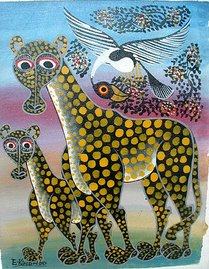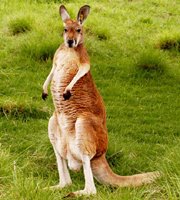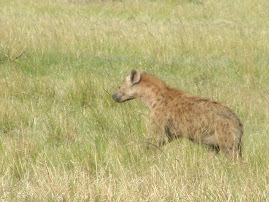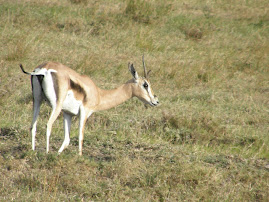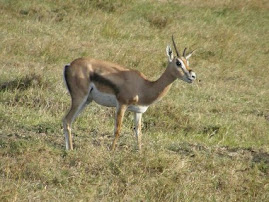On January 11, I drove back to Hobart, turned in the car and caught a late morning flight to Sydney. My flight to Kona didn't leave until 8 pm, so I had plenty of time to peruse the Duty Free shops - which crowd the International Terminal. The Sydney Airport Duty Free shops are a real lesson in marketing for Americans. You simply cannot avoid walking through them because the walkways - duh - go through the stores. This was some of the cheapest liquor I found on my travels, as well as some of the cheesiest souvenirs. But it sure was a great way to kill several hours without hanging out in the bar the entire time.
If America put warnings like this on our cigarette packaging, how many people would quit smoking overnight?

This is a brand of cigarettes by the Philip Morris Company (
http://en.wikipedia.org/wiki/Peter_Jackson_(disambiguation)) and has nothing to do with the Director of the Lord of the Rings trilogy.

My bag did not follow me to Kona from Sydney. It was found within two days, but never made it to Hawaii. There is only one flight a day from Sydney (Qantas) and it just never made it onto the plane. Sydney has stepped up its security screening, and checks each and every bag flying international (or so the airline rep told me). My bag made it through the check after a day or two, but for some reason never got onto a plane. So I had Qantas send it to Los Angeles.
The airline granted me $200 compensation - which I couldn't get until I arrived in L.A. - so I bought some basic supplies, including new bathing trunks and a shirt. I figured as long as I was in Hawaii for the first time, I might as well look like a tourist.

My first cardinal - not a bird I expected to see in Hawaii.

I saw maybe two dogs during my entire time in Hawaii, but lots and lots of feral cats. They freely entered the restaurant sidewalk seating areas and people fed them just as freely. Not too good.
Cruise ships disgorged passengers all day, and they mobbed the beachfront shopping area.

A section of beach with sea wall.

I took a ride on a submarine - the Atlantis IV. The company has a fleet of subs in several locations around the world, and they have been featured in a 1988 National Geographic program (
http://www.atlantisadventures.com/ourstory.cfm).

There were only about 18 of us on board the sub, which can hold up to 48 passengers. We got to see much more of the reef because we all sat on the same side of the sub, making it unnecessary to turn around so the other half of the passengers could see the fish and coral. Our deepest descent was to 102 feet.

OK, let's get this over with. Kona has more than one brewery, but I was only able to make time to visit one of them. Nice sampler, expensive burger.

Kona is home to an Ironman competition, and I saw several swimmers possibly in training.

Right next to the sea wall is the Hulihee Palace, built of coral, lava rock and native wood in 1838. Unfortunately, it was closed for remodeling at the time.



There were three reasons to stop over in Hawaii: 1) My parents and kids have all been there but I haven't, 2) I wanted to do some diving and 3) I wanted to see Volcano National Park. This next picture shows the coastline off which we dove. At the bow of the boat the depth was 20 meters. At the stern, 30 meters. One boat length further out to sea was 70 - 100 meters, and it sloped even more steeply from there. The Hawaiian Islands are surrounded by ocean over 60,000 feet deep. Thankfully, we were only planning to dive the reef just offshore.
The issue that day was the surf. The movement is not limited to the surface of the ocean, but rather carries over to the depths as the wave approaches shore. Once we submerged, we flowed with the surge like a Salvador Dali version of "Chorus Line." I estimate the shift was 12 to 15 feet. I made 4 dives, one of them a night dive where I saw manta rays. HUGE manta rays, with a wingspread over 15 feet. On the third dive, a later afternoon dive, I saw 2 hammerheads below and a ways away from me, swimming across the front of 3 divers at a depth of about 70 feet. It wasn't scary until the sharks turned around and swam back. They simply peeled off and swam out into the deep, however.

Another agenda for Kona was a tour of the volcanoes: Mauna Ulu and Kilauea. We saw more than these, as we drove along the Chain of Craters Road. But before we left for the drive (pickups began before dawn), the van had to pick up passengers at a few resorts, such as The Four Seasons - the most expensive on the island. As we drove out of Kona to the resorts, we passed by lava fields with messages spelled out in coral.

That weekend The Four Seasons was hosting a golf tournament sponsored by MasterCard. We didn't see anybody famous - probably because we were there so early.

The Four Seasons entrance, complete with valets to open doors, carry luggage, and light cigars.

The swimming pool, with the ocean just beyond. When we returned that evening, the torches lit around the pool made it seem very Roman.

On the way out of Kona, we passed several cinder cones. These mounds are created when gas and ash vent from the ground, causing the ash to build up into a cone. They can appear almost anywhere on the island.

Mauna Ulu, with it's summit covered in snow.

The caldera of Kilauea. It currently doesn't erupt, here, because a vent has opened some 30 miles away, draining off the pressure by releasing lava and steam. It's in a remote area, even though there is a subdivision nearby. It is inaccessible except by helicopter, or via this subdivision (which has been closed off and evacuated). In the full-sized photo you could see vehicles on the other side of the caldera.


At the edge of the caldera, the native Hawaiians often leave offerings to Pele, whom legend describes as living in this place. Evidently, Pele likes gin.

After exploring the caldera, we visited the Thurston Lava Tube. The public is allowed into only a small portion of the tube (400 feet) because the ceiling is decaying as water seeps through. It extends for at least 1000 more feet.


We got to walk across an old lava field. Several of us commented at how extensive the flow was, covering the landscape for miles (See map at:
http://www.nps.gov/havo/planyourvisit/upload/map_park.pdf)

One of the Visitor Centers has a sculpted map of The Big Island. The most active volcano is at the bottom right, with the oldest (and dormant) volcano at center left. The tall peak is Kilauea.

There are two main kinds of lava: 'A'a and pahoehoe ("AH'ah" and "pah-OH-ay-oh-ay"). In this photo, 'A'a is on the left. This type of lava is highly viscous, flowing slowly with lots of gas bubbles trapped inside. It cracks
when it cools. Pahoehoe flows much more quickly and smoothly, hardening into a lava which is quite dense.

When lava encounters a forest, it usually mows down the vegetation. If a tree is sturdy enough however, it can be left standing as the lava flows around it. The tree may be consumed in its entirety or some portion may remain. The lava can even "stack up" against the tree, forming a sort of mound. When this mound hardens, it is often hollow and eventually collapses.



Dead trees, still standing, and regrowth after a 1975 lava flow. It takes time for the lava to break down and serve as a foundation for regrowth.

'A'a lava.

Pahoehoe lava that has broken down somewhat.

Pele's tear. This glass-like object is formed when lava is thrown up into the air by gas and steam, forming a thin ribbon. As the ribbon hardens and is blown by the wind, it becomes tear-shaped droplets that harden before they hit the ground. They are fragile, but can be found, even in the older lava field we visited.

On the lave flow was yet another offering to Pele. There's a roasted bird of some kind on the left and flowers. We also saw Monopoly money nearby, which the guide suspected was left by a wise-guy tourist.

This picture not-too-clearly shows the SE coastline of The Big Island, with lava flows. The smoky, light-blue at the top is ocean. The flow we were exploring formed sort of an escarpment, and you can kind of see the land sloping rapidly toward the sea.
































































